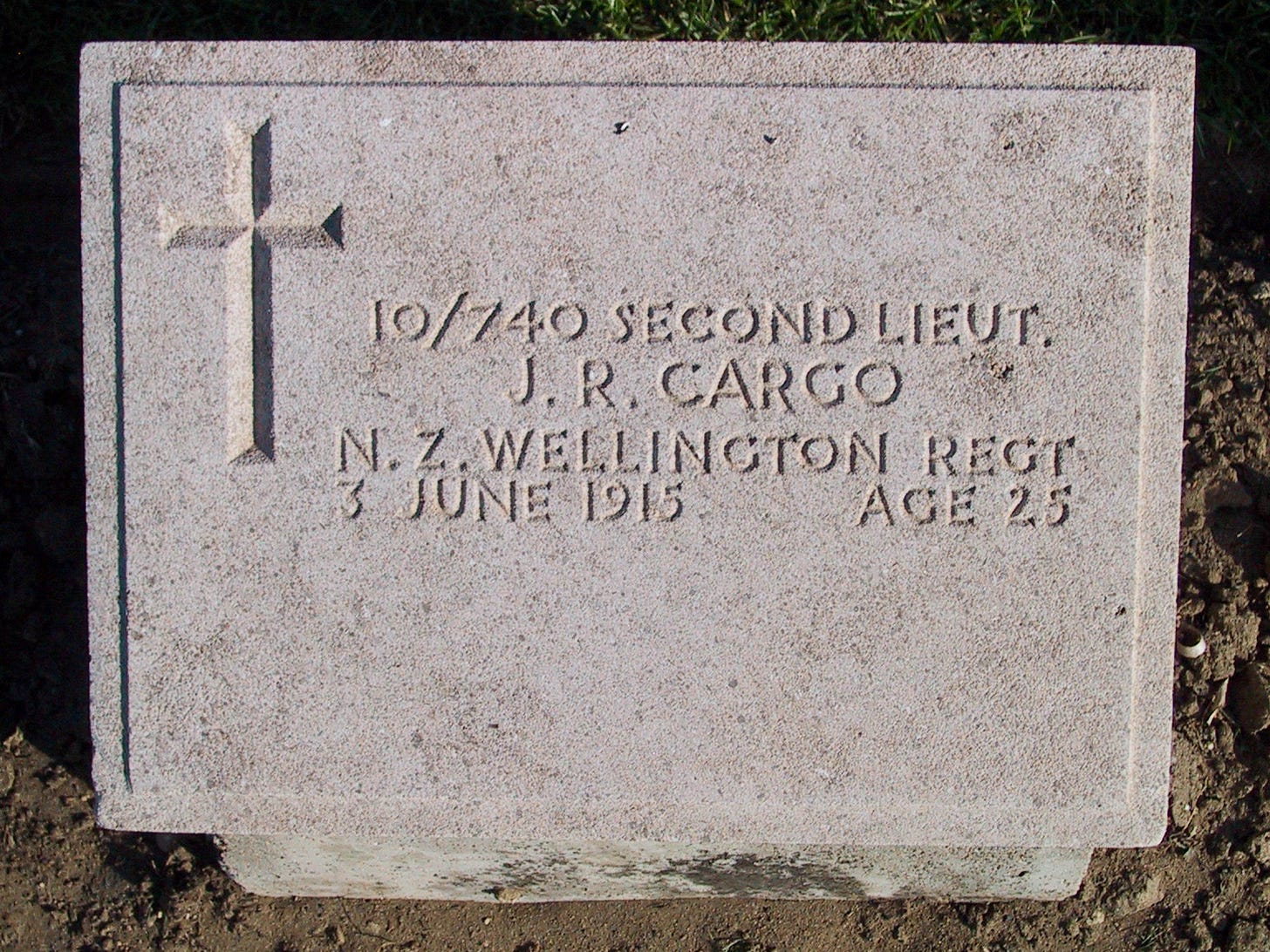25th April, 2021
Week 17/52
Photo by me, taken at Gallipoli, when I was also 25 years old.
It's school holidays, and I’m on the road. So just one thing this week, to fill this intermission…
🖼 Frame
Consider this a wonderful story from Sir Ken Robinson’s book “Out Of Our Minds“:
“A well known British journalist was reminiscing about his early days in radio news. He joined the BBC in the 1930s at a time when there was no regular news bulletin. In his first week, a bulletin was scheduled and he arrived at the studio to watch it being broadcast. The presenter sat at the microphone and waited until the time signal had finished. He then announced sombrely: ‘This is the BBC Home Service from London. There is no news’. The view of the times was that news would be broadcast if anything happened to warrant it.”
Can you imagine anything like that happening today? It’s impossible.
I guess that either there are just a lot more remarkable things happening or we’ve massively lowered our standards on what “warrants” reporting.
While I think a little more about that… did you read this week that Prince Harry spent an hour talking with his father and brother when he was back in the UK for his grand-father’s funeral? 🤨
I’ve spent the last couple of months trying to wean myself off social media, with mixed results so far:
I’ve tried to limit myself to just sharing links to my own work on Twitter (yes I realise this is like quitting drinking but still running a pub).
I’ve removed the apps from my home screen - they are still on my phone but I have to go looking in the app directory, so it at least needs to be more conscious.
I’ve turned off notifications and enabled a time restriction using Screen Time.
I’ve even moved the charger out of my bedroom - so grabbing for my phone is less likely to be a last-thing-at-night or first-thing-in-the-morning habit.
It works … some of the time.
The withdrawal symptoms are real. I often instinctively unlock my phone and then wonder what to do, without the crutch of the Twitter or Instagram icons to tap.
The FOMO is real too. But preferable, I think, to feeling angry or envious.
The reason I’m motivated to keep pushing on this is that I’m using the time I get back to write, and I’m really loving that.
“The problem is no longer getting people to express themselves, but providing little gaps of solitude and silence in which they might eventually find something to say…. What a relief to have nothing to say, the right to say nothing, because only then is there a chance of framing...the thing that might be worth saying.”
— Gilles Deleuze
Addendum
NZVIF
Last week I wrote about the NZ Venture Investment Fund (now called NZ Growth Capital Partners).
I got this question via email, from somebody who has worked directly on multiple successful ventures:
What I hear you saying is that there are a bunch of great startups that were going to succeed anyway - they didn’t need NZVIF.
So it sounds sensible that the NZVIF funds are focused on the next layer down, who might not have succeeded without the funding boost. But it also sounds like the funding boost made no difference to this layer of startups. Why not?
Surely the answer isn’t to focus on companies who will succeed anyway. But to keep investing in the companies who might not succeed anyway. But what else is needed in addition to the funding?
My response:
The entire purpose of NZVIF was to jump start venture capital funds. To succeed over multiple cycles funds need to invest in the best companies. So having an explicit intention that they should invest in the “next layer down” is actually self-defeating. It’s also revisionist - the intention was always to try and invest in the best companies. They just didn’t. Hence, none of the funds survived.
But, yes, I agree there have been lots of successful companies created despite not getting NZVIF funding. (Some might argue because - I’m pretty sure if one of those initial funds had invested in Trade Me it could easily have killed us!)
My suspicion is that New Zealand actually had more than our quota of successful companies over the last cycle. If that number keeps going up it will expose constraints other than availability of capital (e.g. availability of qualified people)
But, that’s stealing a topic from a future post!
PS I was also reminded by somebody else about one of the companies that NZVIF did invest in:

Somehow I’d suppressed that. 🚀
Paul Callaghan
Three weeks ago I wrote about Paul Callaghan, and looked at how his message might have been updated, if he were still here.
With that in mind I was interested to read the recently released report from the Productivity Commission:
Here’s how NZ could be better off without working harder
This report rolls out Paul’s familiar diagnosis (we need more high-growth export businesses) but then unfortunately concludes that we do the exact opposite of what he prescribed as a solution:
To develop large, globally significant firms, the commission recommended the Government narrow its focus to areas of the economy with potential for innovation.
”A small economy has only a limited number of areas that can get to critical mass and support sustained world-class competitive performance,” it said.
“As a complement to broad-based innovation policies (which benefit all firms), finite government resources also need to be deliberately focused on a small number of high-potential areas rather than being thinly spread.”
The report recommends the focus reflect existing and emerging strengths and capabilities and that the Government collaborate with industry and other stakeholders.
And:
The commission wants the Government to set up a high-level strategy body like an Innovation Council, which could include the prime minister, to help define focus areas, and innovation bodies for each focus area.
This completely ignores where our successes to-date have actually come from.
To use the example highlighted in the article, prior to F&P Healthcare we had no history or strength in sleep apnea devices. It’s also worth remembering that F&P Healthcare was a successful business even 10 years ago when Callaghan was sharing his prescription.
What about our more recent successes? They are all weird, pretty much exactly as Paul predicted they would be:
Prior to Xero it was not obvious that we could create a global Software-as-a-Service business, let along one focussed on small business accounting.
Prior to Pushpay few would have guessed that we would create a multi-billion dollar business selling a payment platform to American mega churches.
I can safely predict that a government Innovation Council wouldn’t have picked either of these winners. The existing government venture fund that was investing at the time they were started didn’t pick them.
🙋♂️
Imports
Two weeks ago I wrote about the problems we have blindly using imported solutions, and the idea, also first proposed by Paul Callaghan, that we should be “the place where talent wants to live”.
I noted then:
Those we need to attract are more usefully qualified immigrants, hungry for future success, than billionaires wanting a comfortable retirement playground. A much more interesting question is: why don’t we currently welcome more of them?
Alyona Medelyan, who is the founder and CEO of Thematic (disclaimer: I’m an investor) shared this story in the comments, and I think it’s worth repeating here:
An anecdote to your questions of why not more skilled young people move to NZ:
In my 3rd year of PhD at the Machine Learning department, having just completed a 4 month internship at Google, I applied for permanent residency in New Zealand. I used the skilled migrant category, which uses a point system.
Unfortunately, I got declined...
My PhD (sponsored by Google) wasn’t complete yet, so that didn’t count. My Masters combined Linguistics, Computational Linguistics and Computer Science didn’t count either. They didn’t know what it was.
I got a call from immigration asking if I had a boyfriend to use the partner visa instead. Easier to get. I declined as I wanted to get in on my own. I ended up having to appeal and ultimately got a yes after my case was reviewed. But I wonder how many don’t and move to other countries?
😖
NZ Rugby & Silver Lake
Two weeks ago I wrote about the proposed private equity investment in NZ Rugby (actually I’ve written about this twice - the first time was more oblique).
So it was amazing this week to watch a private equity funded professional sport train wreck happen in real time with the announcement and then prompt reversal of the European Super League plan, featuring most but not all of the top European football clubs.
Two excellent articles on this I recommend to you:
The European Super League Pyramid Scheme
(HT Mark Clare)
The “contradictory imperatives” in this piece may feel familiar.
And also this from the NY Times:
How the Super League Fell Apart
🍿
Lydia Ko
On a much more positive note, four weeks ago I scripted a hypothetical scenario about Lydia Ko for the judges of the Halberg Awards.
Since then she’s been on fire, finishing second at the ANA Inspiration (the most recent major) and then winning an LPGA Tour event in Hawaii with a record score and margin - her first win since 2018 but sixteenth of her career so far (including two majors)!
So, maybe it’s worth asking again: imagine if Ryan Fox had finished second at the recent Masters and then won the next event on the PGA Tour. It would be a nice exclamation point on his Decade Champion of the 2010s award eh?
Photos
Finally, a couple of people have asked about the photos I use.
They are all my own, unless otherwise noted.
As I mentioned in one of the first posts earlier this year, I started sharing some photos on Unsplash and you’ll find most of those I’ve posted here on there.
Enjoy!
Sunrise, this morning, from East Cape Lighthouse.
Top Three is a weekly collection of things I notice in 2021. I’m writing it for myself, and will include a lot of half-formed work-in-progress, but please feel free to follow along and share it if it’s interesting to you.



